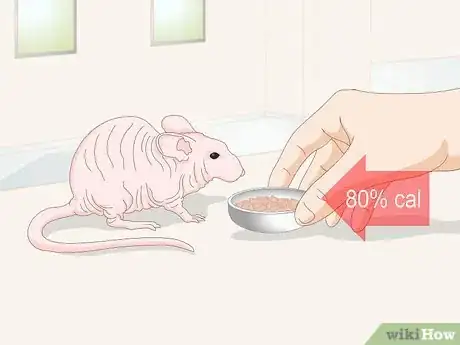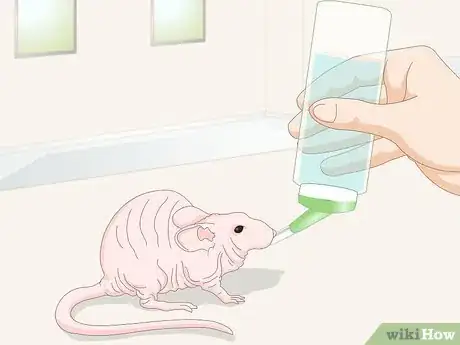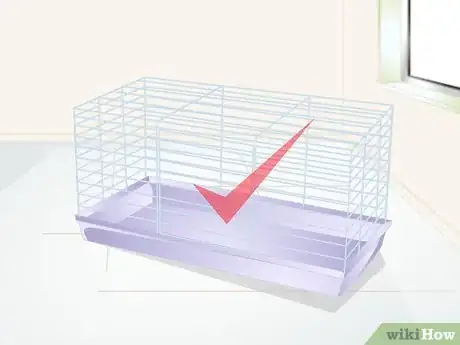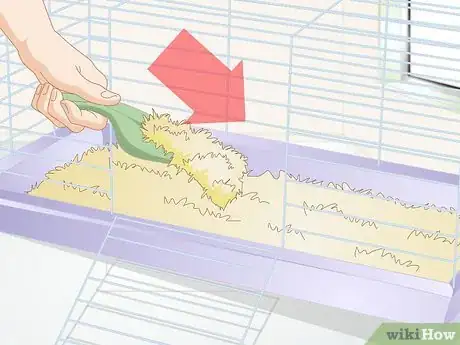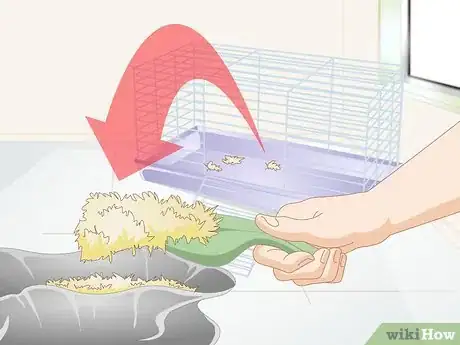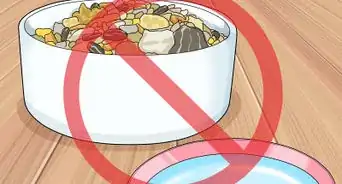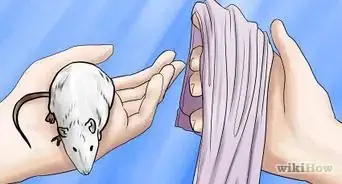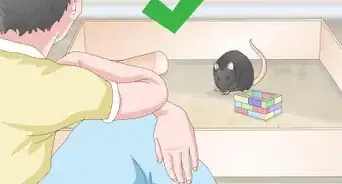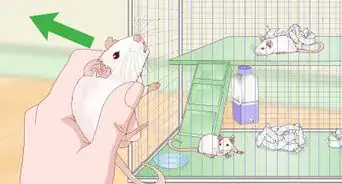This article was co-authored by Pippa Elliott, MRCVS. Dr. Elliott, BVMS, MRCVS is a veterinarian with over 30 years of experience in veterinary surgery and companion animal practice. She graduated from the University of Glasgow in 1987 with a degree in veterinary medicine and surgery. She has worked at the same animal clinic in her hometown for over 20 years.
wikiHow marks an article as reader-approved once it receives enough positive feedback. In this case, 88% of readers who voted found the article helpful, earning it our reader-approved status.
This article has been viewed 50,691 times.
Hairless rats have mostly bald, smooth skin, except for a few patches of hair, such as around the face or on the genitals. Hairless rats make playful, inquisitive pets, but they may require a bit of extra attention due to their lack of hair. You can provide your hairless rat with excellent care by learning about how to feed, house, and protect your rat's health.
Steps
Feeding your Hairless Rat
-
1Give your rat a lab block. Lab blocks provide all of the vitamins and nutrients that your rat needs to be healthy, so they should make up the majority of your rat’s calories (about 80%). Hairless rats may eat more than their furry counterparts because they require more energy to stay warm, so plan to check on your rat’s food supply often.
- Keep in mind that male rats require less protein and pregnant and nursing female rats require more protein. For males, find a lab block that contains 16 to 18% protein. For pregnant or nursing females, look for a lab block that contains about 22% protein. Lab blocks made with soy are also beneficial for female rats.
-
2Offer some fresh fruit and vegetables to your rat. Rats like to munch on fresh fruits and vegetables as well, so try to offer your rat a piece of something fresh to munch on every day. Some good fruit and vegetable choices for your rat include:
- strawberries
- watermelon
- pears
- apples
- plums
- kiwi
- zucchini
- spinach
- broccoli
- cauliflower
- carrots
Advertisement -
3Let your rat have a special treat now and then. Other foods can provide great nutritious treats for your rat as well. Just make sure that these are given in moderation, such as once or twice per week. Some good occasional treats for your rat include:
- canned oysters
- small pieces of meat such as beef, chicken, or shrimp
- dog biscuits
- yogurt
- low-sugar cereal
-
4Provide your rat with plenty of water. Rats need to stay hydrated and water is the best thing for them to drink. Make sure that your rat always has access to plenty of clean, fresh water in a sipper water bottle.
- Do not give your rat a dish of water. Rats can kick feces and food into the water and contaminate it. It is also easy for your rat to kick his water over and this can lead to dehydration.[1]
- Hairless rats also drink more water than regular rats, so you may need to check the water bottle more often.
-
5Prevent your rat from eating certain foods. Rats can eat almost anything, but some foods may be harmful for your rat if he eats too much of it.[2] Try to prevent your rat from eating anything in excess and he should be fine. Some foods to avoid giving your rat include:
- green bananas
- green potato skins
- oranges
- artichokes
- onions
- dry beans
- raw sweet potatoes (cooked ones are okay)
- rhubarb
- raw peanuts (roasted ones are okay)
- wild insects
- blue cheese
Tending to the Rat’s Cage
-
1Choose a proper cage for your rat. A wire cage, similar to a bird cage, is best. You can also house your rats in an aquarium or glass tank. As you choose a cage for your rate make sure that you consider:[3]
- Size. Your rat will need to have room to run around and play in his cage. Make sure that you get a cage that is large enough for your rat to run around in. The general rule is 2 square feet per rat.
- Floor. If you decide to go with a wire cage, then make sure that the bottom is solid metal rather than wire. Rats can get their feet caught in wire-bottom cages and this can lead to broken limbs and infections.
- Play spaces. It is important to provide ladders and shelves within the cage so that your rat can climb around and play.
- Wire Spacing. For adults, wire spacing should be equal or less than 1 inch. Remember, any hole a rat can get it's head through, it can get the rest of its body through. For babies, it's recommended to have a wire spacing of 1/2 inch or smaller.
-
2Select softer bedding. Both hairless and regular rats require bedding material on the bottom of the cage to run, dig, and sleep. While wood chips such as aspen are fine for regular rats, the sharp edges can cut the skin of a hairless rat. Wood chips can also dry out the skin. Use paper bedding or recycled newspaper instead. You can also use a soft blanket made from fleece.[4]
- Do not use cedar or pine shavings as they can cause respiratory problems in rats.
-
3Change the bedding often. Hairless rats are more vulnerable to respiratory infections including mold. If you are cleaning bedding a couple of times per week for regular rats, then you need to change it three times or more for hairless rats.
- To change the bedding in your rat’s cage, dump the soiled bedding into a garbage bag and dispose of it outside.
- Spray the cage with water and scrub it with a pet brush and soap. Make sure that you rinse off the soap residue with warm water.
- Then, dry the inside of the cage with towels and add fresh bedding.[5]
-
4Adjust the ambient temperature. Hairless rats get chilled easier than regular rats. In addition to keeping the cage out of drafty areas, you should set the room’s temperature to the low-to-mid 70s Fahrenheit (low-to-mid 20s centigrade).[6]
- A heat lamp, such as the type used in reptile enclosures, may also help to keep your hairless rat warm on chilly days.
-
5Consider putting a hairless rat with a furry rat. Rats are highly social pets like many other small pets. As with most small pets, it is best to keep two pets of the same gender and similar age together. Hairless rats enjoy cuddling into the fur of the regular breed companion. However, you also need to put in additional boxes or pet “hammocks” for the rats to sleep in separately if they choose.[7]
- Occasionally, the furry rat will scratch the hairless rat when in close proximity—though not necessarily due to fighting.
Keeping your Rat Healthy
-
1Take your rat for regular veterinary checkups. Regular veterinary visits will help to keep your hairless rat in good health and catch any problems before they become severe. Take your rat to see a veterinarian soon after you get him or her. You should also watch for signs that your rat may be sick and take him to see a veterinarian if you notice anything unusual. Some signs of illness in rats include:[8]
- lethargy
- dull coat or puffy looking coat
- loss of appetite
- wheezing, raspy breathing, or other signs of respiratory distress
- sneezing
-
2Bathe your rat if necessary. Most rats do a good job of grooming themselves, so it is not necessary to bathe your rat often. However, you may decide to give your rat a bath if he develops a bad smell. At most, you should only need to bathe your rat once or twice per year.
- To bathe your rat, fill the bathroom sink with warm water.
- Then, use one hand to dunk the rat under the water to the head (not the head under the water).
- Use your other hand and a toothbrush to lather a tiny bit of standard human shampoo on the rat’s skin. Avoid getting soap in the rat’s eyes or mouth.
- Rinse off all of the soap.
- Dry the rat with a towel, and move the rat to a clean cage to let him dry.
- Consider using a heat lamp, or hair dryer over the drying cage to speed up the drying process.
-
3Wipe your rat’s eyes. Your rat's eyes may need some attention now and then as well to keep them clean. To clean your rat's eyes, get a cosmetic sponge and run it under some warm water. Dab the sponge gently along both of your rat’s eyes and wipe away any debris that you notice.
- Expect to see some little red flakes or “porphyrin.” In small amounts this is normal, but if you see excessive amounts then you should consult a veterinarian.[9]
- Don’t use tissues or paper towels for eye cleaning as such products can leave pieces of cloth behind.
-
4Massage the skin. Skin irritation is a major source of concern for hairless rats. One way to keep your rat’s skin in good condition is to give him or her an olive oil massage, which will not hurt your rat if he ingests it.[10]
- To give your rat an olive oil massage, pour a small amount of olive oil into a small container and dip in your fingertips. Rub your oil coated fingertips on all areas of your rat’s skin except the eyes, mouth, and inner ears.
- Repeat this massage once a week.
- Follow up the massage with a high protein snack as a reward. Perhaps a piece of chicken, turkey, beef, or cube of cheese.
Expert Q&A
-
QuestionCan you bathe a hairless rat?
 Pippa Elliott, MRCVSDr. Elliott, BVMS, MRCVS is a veterinarian with over 30 years of experience in veterinary surgery and companion animal practice. She graduated from the University of Glasgow in 1987 with a degree in veterinary medicine and surgery. She has worked at the same animal clinic in her hometown for over 20 years.
Pippa Elliott, MRCVSDr. Elliott, BVMS, MRCVS is a veterinarian with over 30 years of experience in veterinary surgery and companion animal practice. She graduated from the University of Glasgow in 1987 with a degree in veterinary medicine and surgery. She has worked at the same animal clinic in her hometown for over 20 years.
Veterinarian Hairless rats are prone to dry skin, so whilst occasional baths are a good idea, be careful not to over-bathe them. Use a mild moisturizing shampoo, such as a pet shampoo containing oatmeal, and dry the pet well afterward.
Hairless rats are prone to dry skin, so whilst occasional baths are a good idea, be careful not to over-bathe them. Use a mild moisturizing shampoo, such as a pet shampoo containing oatmeal, and dry the pet well afterward. -
QuestionWhat is the lifespan of a hairless rat?
 Pippa Elliott, MRCVSDr. Elliott, BVMS, MRCVS is a veterinarian with over 30 years of experience in veterinary surgery and companion animal practice. She graduated from the University of Glasgow in 1987 with a degree in veterinary medicine and surgery. She has worked at the same animal clinic in her hometown for over 20 years.
Pippa Elliott, MRCVSDr. Elliott, BVMS, MRCVS is a veterinarian with over 30 years of experience in veterinary surgery and companion animal practice. She graduated from the University of Glasgow in 1987 with a degree in veterinary medicine and surgery. She has worked at the same animal clinic in her hometown for over 20 years.
Veterinarian The average lifespan of a hairless rat is considerably shorter than for haired rats, at around 12 months. This is because the gene coding for hairlessness also inhibits the formation of part of the immune system. This makes hairless rats less able to fight infections and more likely to die young.
The average lifespan of a hairless rat is considerably shorter than for haired rats, at around 12 months. This is because the gene coding for hairlessness also inhibits the formation of part of the immune system. This makes hairless rats less able to fight infections and more likely to die young.
Warnings
- Don’t use tissue or paper towels for eye cleaning.⧼thumbs_response⧽
- Hairless rats will need more skin care than typical rat varieties.⧼thumbs_response⧽
- Avoid cedar and pine shavings when selecting bedding materials for rats.⧼thumbs_response⧽
References
- ↑ http://www.rmca.org/Resources/rmcafaq.htm
- ↑ http://www.rmca.org/Resources/rmcafaq.htm
- ↑ http://www.rmca.org/Resources/rmcafaq.htm
- ↑ http://animals.mom.me/hairless-vs-fancy-rats-pets-2436.html
- ↑ http://animals.mom.me/hairless-vs-fancy-rats-pets-2436.html
- ↑ http://animals.mom.me/hairless-vs-fancy-rats-pets-2436.html
- ↑ http://animals.mom.me/hairless-vs-fancy-rats-pets-2436.html
- ↑ http://www.rmca.org/Resources/rmcafaq.htm
- ↑ http://www.ratwhisperer.net/hairless-rat-skin-care/
About This Article
To care for a hairless rat, prepare a cage with at least 2 square feet of floor space, and line it with paper bedding or newspaper. Make sure to clean the bedding 3 times a week, since hairless rats are prone to respiratory infections caused by dirty cages. Additionally, provide your rat with a lab block to eat, which will give it all the vitamins and minerals it needs to be healthy. You can also offer it fruits and vegetables, like strawberries or carrots, once a day to give it something fresh to eat. For advice from our Veterinary co-author on how to bathe your rat if it starts to smell, read on!
